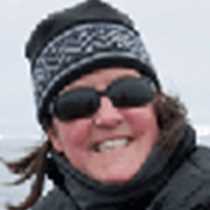Diskobukta, Svalbard
The many faces of the Arctic can be experienced in just one day. In the morning we awoke to a chilly foggy mist that obscured the shoreline along Cape Lee. Svalbard is known for intense fog that can shroud the shorelines in the summer because of warm air temperatures colliding with cool sea temperatures. We went there hoping to see if walrus were resting at a traditional haul out site, but even through the heavy gray mist, the scout boats could not find any.
Steadily the National Geographic Endeavour made its way back out into the pack ice. Slowly but surely the fog cleared and we could again see the dramatic landscapes. Just before reaching Diskobukta, our eagle eyed Captain spotted a small group of walrus swimming towards the ship just after an excellent presentation about polar bears by Stefan Lundgren. We raced out on deck to see several of the male walruses popping their heads above the surface with their long tusks clearly visible.
After lunch we went ashore at Diskobukta to see a rare and incredible site. From the ship's deck we could see hundreds of birds swirling above a cliff edge. This urged us to decided our destination. We walked along a sandy beach up through a canyon edge. The humming of the birds became louder with each step. As we entered the canyon, we saw two Arctic foxes on either side of the cliff edges patrolling for eggs of the thousands of kittiwakes nesting above. One fox was very white as it still had not molted its winter fur coat while the other one was much more mottled tan with its summer coat colors. It was a wonderful look at one of the Arctic's top predators.
We made our way into the narrow canyon to see thousands of birds swirling above. The cacophony of so many kittiwakes in one small area was deafening! Their common name comes from their calls; and those calls echoed all around us. Kittiwakes are the most numerous of the gull species. You can tell them apart from other gulls because their wingtips look like they have been dipped in black ink. We could see so many nests built from seaweed and moss sitting right on the edge of these steep knife like cliffs. This good breeding strategy protects their nests from Arctic foxes. However, we still saw remains of egg shells scattered along the path of the canyon floor. It was one of the best opportunities to have such a close encounter with so many cliff nesting seabirds.
The many faces of the Arctic can be experienced in just one day. In the morning we awoke to a chilly foggy mist that obscured the shoreline along Cape Lee. Svalbard is known for intense fog that can shroud the shorelines in the summer because of warm air temperatures colliding with cool sea temperatures. We went there hoping to see if walrus were resting at a traditional haul out site, but even through the heavy gray mist, the scout boats could not find any.
Steadily the National Geographic Endeavour made its way back out into the pack ice. Slowly but surely the fog cleared and we could again see the dramatic landscapes. Just before reaching Diskobukta, our eagle eyed Captain spotted a small group of walrus swimming towards the ship just after an excellent presentation about polar bears by Stefan Lundgren. We raced out on deck to see several of the male walruses popping their heads above the surface with their long tusks clearly visible.
After lunch we went ashore at Diskobukta to see a rare and incredible site. From the ship's deck we could see hundreds of birds swirling above a cliff edge. This urged us to decided our destination. We walked along a sandy beach up through a canyon edge. The humming of the birds became louder with each step. As we entered the canyon, we saw two Arctic foxes on either side of the cliff edges patrolling for eggs of the thousands of kittiwakes nesting above. One fox was very white as it still had not molted its winter fur coat while the other one was much more mottled tan with its summer coat colors. It was a wonderful look at one of the Arctic's top predators.
We made our way into the narrow canyon to see thousands of birds swirling above. The cacophony of so many kittiwakes in one small area was deafening! Their common name comes from their calls; and those calls echoed all around us. Kittiwakes are the most numerous of the gull species. You can tell them apart from other gulls because their wingtips look like they have been dipped in black ink. We could see so many nests built from seaweed and moss sitting right on the edge of these steep knife like cliffs. This good breeding strategy protects their nests from Arctic foxes. However, we still saw remains of egg shells scattered along the path of the canyon floor. It was one of the best opportunities to have such a close encounter with so many cliff nesting seabirds.



